| |||
 |
| Although Korea is currently separated into the south and the north, the nation was once divided into eight provinces according to the administrative districts of the Joseon Dynasty. The northern region included Hamgyeong Province, Pyeongan Province and Hwanghae Province; the central region consisted of Gyeonggi Province, Chungcheong Province and Gangwon Province; and the southern region comprised Gyeongsang Province and Jeolla Province.
Topographically, Korea stretches out from north to south and is narrow from east to west. Therefore, the climate varies greatly from the northern region to the southern region. Since the northern region is mountainous while the southern region has more plains, their produce are also quite different. In each region, commoners cooked local produce generation after generation based on the local characteristics and historical tradition stemming from the unique climate, topography and produce. People traditionally acclimatized to the natural characteristics, found suitable methods through experience and incorporated them into their dietary habits and created a local food culture.
Moreover, the flavor and presentation of food are also closely associated with climate. Since the summer is short and the winter is long in the northern region, the food is not as salty or spicy as the food of the southern region. Its food itself is larger and people tend to prepare a generous amount, indicating the personality of the local people. On the other hand, dishes to the south are saltier and spicier, and seasonings and salted fish are used more.
Since the northern region is mostly mountainous, dry-field farming is common and cereal crops are produced in abundance. Meanwhile, in the central region bordering on the western coast and the southern region, rice crops are the main product. Therefore, while those living in the northern commonly ate rice mixed with cereals as their staple, those living in the south ate plain rice or rice mixed with barley.
In mountainous regions, meat and fresh fish are scarce. Therefore, salted or dried fish and seaweed and mountain plants are often used. In coastal and island regions, fish, shellfish and seaweed harvested from the sea are used as the main ingredients in dishes.
Before transportation was developed, local products were distributed within a short range and each region therefore created unique but modest foods according to local characteristics. Today, although a foreign food culture has been introduced as a result of the development of foreign civilizations and education and improved living standards offer us with opportunities to enjoy Western foods, the flavor and zest of Korea's unique local dishes that has been passed down through generation still thrives.
① Seoul
Seoul has been a capital city for over six hundred years, since the early Joseon Dynasty, and the tradition of the food culture of the royal court has survived and had a great influence on the food culture of the noble class and the middle class. Families of high-ranking officials prepared dishes based on the foods of the royal court. Naturally, the food of the nobility and of the royal court have many things in common. The nobility also stressed formality due to the influence of Confucianism. However, true-born Seoulites are frugal and don't cook excessive amounts. Instead, they prepare a great variety of dishes and make them look attractive by preparing the foods in small and appealing shapes.
Food in the Seoul area is showy and includes splendid dishes such as sinseollo, gujeolpan (platter of nine delicacies) and tangpyeongchae (mung bean jelly mixed with vegetables and beef), which are decorated using garnishes in five different colors, such as paper-thin slices of fried egg, sliced chili peppers and manna lichen. Food is often seasoned with salted shrimp juice but moderately salted. A variety of side dishes are enjoyed, including dried salted fish and pickled vegetables. Rice served in broth, such as seolleongtang (ox bone soup) and gomtang (thick beef bone soup), is popular in Seoul. The origin of seolleongtang (ox bone soup) is the royal plowing ritual held in February at the Seonnongdan alter outside of Dongdaemun in the Joseon Dynasty. In addition, envoys and high-ranking officials returning from China brought with them pots set over a burner in which all sorts of delicacies were placed and boiled. This was called yeolgujatang, which is referred to as sinseollo (royal hot pot) today.
② Gyeonggi Province The food of Gyeonggi Province is modest but diverse. Except for dishes enjoyed in the Gaeseong area, the food is generally plain and simple. The dishes are moderately salted and similar to the food of the Seoul area. Spices are used in moderation. The barbecued beef ribs of Suwon gained popularity when cattle traders from all over the nation gathered at the cattle market that had existed since the Joseon Dynasty and barbecued rib restaurants started to open in Suwon. In the Gaeseong area, joraengi rice cake soup, a soup cooked with long, white rice cakes cut in the shape of caterpillars with a wooden knife, and yakgwa, a blend of flour, sesame oil, alcohol, ginger juice and salt pressed thin and cut in squares, deep fried and coated with starch syrup, are popular foods. ③ Chungcheong Province Although the western coastal area has a rich supply of seafood, fresh fish was scarce in the northern region and inland areas. Long ago, only salted or dried seafoods were enjoyed in these regions. In the mountainous sections of the northern inland, wild vegetables and mushrooms are readily available, and dishes using these as their main ingredients are well known. Bean paste is often used to season food. The food is not lavish and seasonings are used sparingly in order to preserve the natural flavor of ingredients. In winter, beans are boiled and stored in a wooden box or basket for two or three days. When a sticky paste is formed, the beans are ground and seasoned. This is used to cook cheonggukjang (thick soybean paste soup) by adding bean curd or kimchi. Olgaengi, a freshwater shellfish found in clear and shallow brooks, is used in soups and bean paste stew or boiled and seasoned to be served with drinks. Oysters caught offshore of Seosan are rinsed with seawater and salted. After being stored for about two weeks, they are seasoned in fine chili powder. This is called eoriguljeot. ④ Gangwon Province
In Gangwon Province, dry-field farming is more common than rice cultivation. Therefore, corn, buckwheat and potatoes are the main products of the region. In the past, acorn and wild vegetables were consumed to relieve famine, although they are often used as fancy dishes today. By the East Sea, pollack, squid and seaweed are abundant and processed into dried pollack, dried squid, dried seaweed, salted pollack roe and salted pollack intestine. Potatoes can be served steamed or fermented to produce starch, which is used to make noodles, sujebi (soup with pulled dough morsels), porridge and songpyeon (half-moon rice cake). Buckwheat dough is pan-fried and made into rolls filled with seasoned radish. This is called buckwheat chongtteok. The original buckwheat noodle is prepared by mixing buckwheat powder with hot water, pressing the dough through a noodle frame and topping the noodles with radish kimchi and seasoned chili paste. However, this is better known as Chuncheon makguksu (Chuncheon style buckwheat noodles with vegetables) today, which is made with the liquid from water kimchi or pheasant broth. ⑤ Jeolla Province
In Jeolla Province, produce from the land, the ocean and the mountains are equally available and abundant. The ingredients are very diverse and the effort put into preparing dishes is unusually great. Therefore, the food of Jeolla Province is the most lavish and extravagant found anywhere in Korea. Every town, including Jeonju, Gwangju and Haenam, was home to members of the affluent noble class. They are towns of flavor and zest where the finest dishes of these households has been passed down from generation to generation. Since the climate is relatively warm in Jeolla province, the food is salty and strongly seasoned with salted fish, chili powder and spices. As a result, the foods are spicy, salty and pungent. Some examples are gatssam kimchi, godulppaegiji, salted fish, sliced dried octopus, boiled pork, fermented thornback and bibimbap (rice mixed with vegetables).
Today, dolsot bibimbap (bibimbap in a hot stone pot) is known as Jeonju bibimbap (Jeonju style bibimbap). However, in the past, it was not served in a hot stone pot but in a brass bowl. In addition, Jeonju bean sprout soup with rice is a hot dish of rice boiled in a bean sprout soup and seasoned with salted shrimp. This is popular early in the morning as a soup for sobering up.
Hongtaksamghap is a combination of well-fermented thornback, slices of boiled pork and sour kimchi, usually served with rice wine.
⑥ Gyeongsang Province
As Gyeongsang Province has good fishing grounds in the South Sea and the East Sea, the region is rich in marine products. Nakdong River, which meanders through North and South Gyeongsang Province, features a large volume of water and creates fertile agricultural land, which in turn provides abundant agricultural products. The food of the region is generally spicy and salty, and pungent and sweet as well. The dishes are not excessively decorated or lavishly adorned; they appear plain and modest. However, herbs and Chinese pepper are added to create a unique aroma. Fresh fish caught in the ocean are consumed raw as sashimi or cooked in soups or served steamed or broiled. Bean paste is popular in Gyeongsang Province. Makjang and dambukjang in particular are often enjoyed. In Jinju bibimbap (also known as hwaban), Andong sikhae, Dongrae pajeon (seafood and green onion pancake) and loach soup are well known. ⑦ Jeju Island
As Korea's southernmost island, Jeju Island features a warm climate. Several unique species of fish are caught offshore there. The residents of sea villages used to fish and female divers would catch fish underwater. In mountain villages, mountains were reclaimed for farming and mushrooms, wild plants and ferns were collected at Hallasan Mountain. Rice production is scarce. Instead, bean, barley, millet and sweet potatoes are cultivated in abundance. Tangerines, abalone and breams are the most well-known specialty products.
The diligence and modesty of Jeju residents are reflected in their food. They don't prepare food in large quantities. Seasonings are not used much and the food is relatively salty. Jeju Island has traditionally been a famous center of abalone harvesting. These can be enjoyed raw in the form of sashimi. Abalone porridge, which is cooked by stir-frying rice that has been soaked in water with sesame oil, boiling the rice after adding water and bluish fresh intestines and adding sliced abalone, is a delicacy with a unique aroma and a bluish color. Buckwheat powder is made into a soft dough and pan-fried in paper-thin slices, then made into rolls filled with white radish slices. This is called bingtteok, a local dish of Jeju Island that is central to rituals and banquets.
| ||||||||||||
■ The Previous Articles 1) Overview of Korean Food 2) Seasonings and Style of Korean Food 3) Special Food for Seasonal Occasions 4) Royal Cuisine- royal meal and royal table setting for celebratory occasions 5) Royal Cuisine – Who made royal cuisines? 6) Kimchi, the fundamental Korean food http://english.visitkorea.or.kr/ |
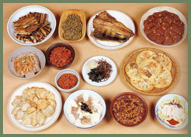
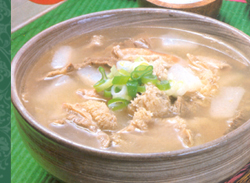
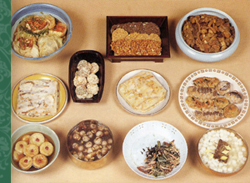
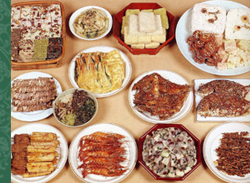
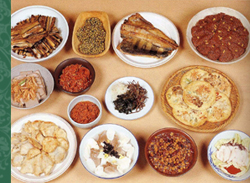
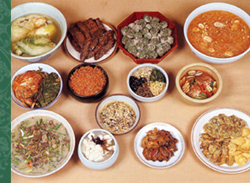

댓글 없음:
댓글 쓰기